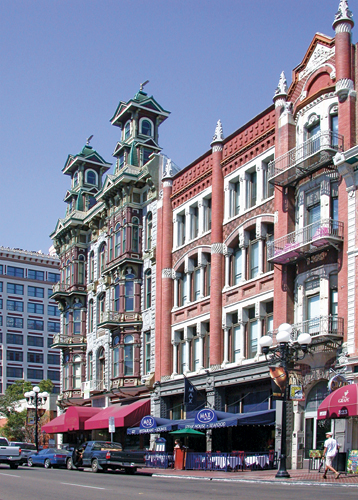|
Just the Facts
The Economics of Historic Preservation
Information compiled by Alana Coons

(Left to right) The Louis Bank of Commerce (1888), Stannard & Clements, architects, and the Nesmith-Greely building (1888), Comstock & Trotsche, architects. These historic buildings in the Gaslamp Quarter Historic District are prime examples of historic preservation as sustainable economic revitalization along with the associated benefits of aesthetic, cultural, social, educational and environmental value.
|
Historic preservation is a proven partner in developing local economies. Through the revitalization of downtown areas and residential neighborhoods, historic preservation generates jobs promotes commerce and tourism; enhances property values; and expands the tax base. The role played by historic preservation programs makes historic preservation an indispensable economic development tool for the county and cities of San Diego. Proven time and time again, it's a simple strategy used all over the world to create economically viable, sustainable and livable communities.
- Rehabilitation, revitalization of downtown and commercial centers of our communities promote investment in the local economy
- Rehabilitation of historic properties create construction jobs at a greater rate than for new construction
- Annual economic benefits nationwide: $77.7 billion in the Institutional Rehab and additions market. $37.1 billion in the Commercial and Industrial Rehab and additions market. $47.7 Billion in the Old House Restoration and Renovations market
- Rehabilitation projects are typically 60 to 70 percent labor as compared to the 50 percent labor that is typical for new construction
- Rehabilitation of historic properties provide cost-effective, affordable housing for low- and moderate-income residents
- Historic preservation offers communities an alternative to sprawl and saves public dollars by avoiding the need to build the infrastructure necessary to service new developments
- Maximizing use of already existing infrastructure saves tax dollars from being spent on expensive new sewers, water lines, and roads
- Historic sites and structures create attractions for heritage tourists, who are the highest on average spenders of all tourists. They spend more, stay longer and visit more places than tourists in general
- Historic sites and attractions create jobs for local residents
- Historic preservation programs are proven engines of economic growth, attracting private investment into our downtowns and neighborhoods
- Virtually every example of sustained success in downtown revitalization, regardless of the size of the city, has included historic preservation as a key component of the strategy
- There is no evidence whatsoever that historic districts reduce property values. Instead the facts show without exception that properties subject to the protection of local historic districts experience rates of property appreciation greater than the rest of the local market and greater than in similar undesignated neighborhoods. Rehabilitation of historic properties increases property values. Historic district designation protects and enhances property values.
|
MORE FROM THIS ISSUE
The Broadway Fountain
San Diego's Historic Warehouse District
Just the Facts
National City & Otay Railroad Depot
The Inside Story
2007 Most Endangered List
Sim Bruce Richards
2007 People In Preservation Award Winners
Baseball Returns Downtown
Reflections
Lost San Diego
Strength in Numbers
Advertisements
DOWNLOAD full magazine as pdf (24mb)
|




